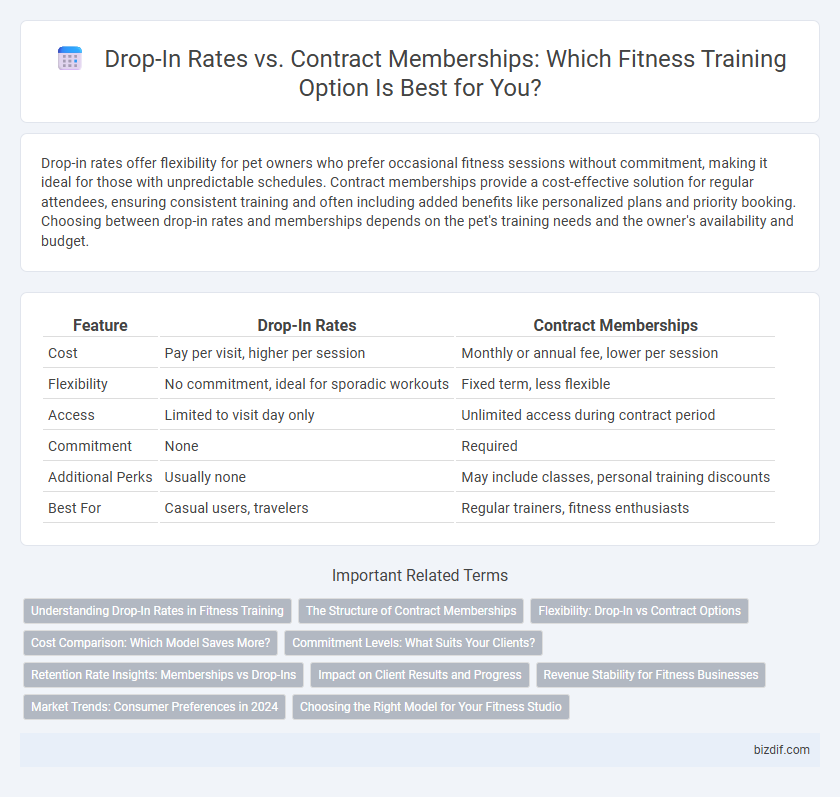Drop-in rates offer flexibility for pet owners who prefer occasional fitness sessions without commitment, making it ideal for those with unpredictable schedules. Contract memberships provide a cost-effective solution for regular attendees, ensuring consistent training and often including added benefits like personalized plans and priority booking. Choosing between drop-in rates and memberships depends on the pet's training needs and the owner's availability and budget.
Table of Comparison
| Feature | Drop-In Rates | Contract Memberships |
|---|---|---|
| Cost | Pay per visit, higher per session | Monthly or annual fee, lower per session |
| Flexibility | No commitment, ideal for sporadic workouts | Fixed term, less flexible |
| Access | Limited to visit day only | Unlimited access during contract period |
| Commitment | None | Required |
| Additional Perks | Usually none | May include classes, personal training discounts |
| Best For | Casual users, travelers | Regular trainers, fitness enthusiasts |
Understanding Drop-In Rates in Fitness Training
Drop-in rates in fitness training offer flexible access to gym facilities without long-term commitment, typically priced higher per session compared to contract memberships. These rates appeal to individuals with irregular schedules or those wanting to try different gyms before committing. Understanding drop-in pricing helps clients evaluate cost-effectiveness based on workout frequency and personal fitness goals.
The Structure of Contract Memberships
Contract memberships in fitness training typically involve a fixed-term commitment ranging from three to twelve months, offering a structured payment plan with consistent monthly fees. These memberships often include added benefits such as access to specialized classes, personal training sessions, and priority booking, which are not available with drop-in rates. The structured payment model encourages participant consistency and long-term fitness progress while providing gyms with predictable revenue streams.
Flexibility: Drop-In vs Contract Options
Drop-in rates offer unparalleled flexibility, allowing members to pay per session without long-term commitment, ideal for those with unpredictable schedules. Contract memberships require a fixed term, providing cost savings but limiting the ability to skip sessions or pause membership without penalties. Choosing between drop-in and contract options depends on individual lifestyle needs and fitness consistency goals.
Cost Comparison: Which Model Saves More?
Drop-in rates offer maximum flexibility by allowing payment per session, often costing between $15 to $30 each, making them ideal for occasional gym users. Contract memberships typically require a monthly fee ranging from $40 to $70 but provide unlimited access and additional perks like group classes and personal training discounts. For individuals training more than twice a week, contract memberships generally save more money compared to repeatedly paying drop-in fees.
Commitment Levels: What Suits Your Clients?
Drop-in rates offer unmatched flexibility for clients who prefer occasional workouts without long-term obligations, ideal for those with unpredictable schedules or trying new fitness programs. Contract memberships provide cost savings and structured commitment, motivating consistent attendance and progress for clients seeking routine and accountability. Fitness trainers should assess clients' lifestyle, goals, and commitment preferences to recommend the best option that enhances adherence and results.
Retention Rate Insights: Memberships vs Drop-Ins
Contract memberships demonstrate significantly higher retention rates than drop-in rates, as members are more likely to commit to consistent training schedules over time. Drop-in users often exhibit sporadic attendance, leading to lower overall engagement and reduced long-term fitness progress. Fitness centers leveraging contract memberships benefit from predictable revenue streams and enhanced client loyalty, supporting sustained business growth.
Impact on Client Results and Progress
Drop-in rates offer flexibility for clients who prioritize convenience but may hinder consistent progress due to irregular attendance, limiting measurable fitness gains. Contract memberships promote steady participation through structured commitments, enhancing workout frequency and enabling trainers to tailor programs for sustained improvement. Commitment-based memberships typically result in more significant client outcomes and long-term fitness success compared to sporadic drop-in sessions.
Revenue Stability for Fitness Businesses
Drop-in rates provide immediate cash flow but result in unpredictable revenue streams for fitness businesses, making financial forecasting challenging. Contract memberships enhance revenue stability by securing consistent monthly income and improving client retention rates. Maintaining balanced offerings between drop-in and contract options optimizes cash flow while fostering long-term financial growth.
Market Trends: Consumer Preferences in 2024
In 2024, market trends indicate a growing consumer preference for the flexibility offered by drop-in rates over traditional contract memberships, driven by the rise of boutique gyms and digital fitness platforms. Data from industry reports show a 25% increase in drop-in session purchases, reflecting a shift toward pay-as-you-go models that cater to diverse schedules and varying workout intensities. Despite this, contract memberships remain popular for access to premium amenities and long-term cost savings, especially among dedicated fitness enthusiasts seeking structured training programs.
Choosing the Right Model for Your Fitness Studio
Drop-in rates offer flexibility for clients seeking occasional workouts without long-term commitment, attracting casual visitors and boosting short-term revenue. Contract memberships provide steady income and foster member loyalty, ideal for studios focusing on long-term client engagement and consistent attendance. Evaluating your target market's preferences and cash flow needs helps determine whether a flexible pay-as-you-go model or commitment-based pricing better aligns with your fitness studio's growth strategy.
Drop-In Rates vs Contract Memberships Infographic

 bizdif.com
bizdif.com